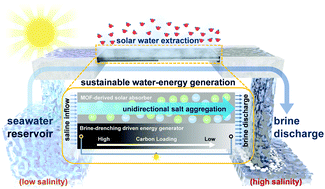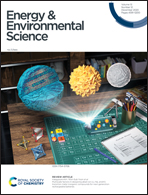Manipulating unidirectional fluid transportation to drive sustainable solar water extraction and brine-drenching induced energy generation†
Abstract
Water and energy are intimately intertwined, and it is high time to put forth integrated approaches to address the challenges and opportunities of the water–energy nexus. Herein, a novel fluidic photothermal structure integrated with a brine-drenching induced electricity generator is reported for simultaneous clean water and power production. The fluidic photothermal structure is capable of sustaining solar-thermal distillation systems (e.g. interfacial and multi-stage configurations) at high energy conversion efficiency while completely preventing salt formation from occurring in the long-term desalination process, by taking advantage of unidirectional brine fluid transportation. The brine-drenching induced electricity allows immediate power generation with a piece of wet fabric only. Furthermore, the fabric-based energy generator exhibits remarkable programmable properties, and we have also demonstrated that power generation is also achievable with different water sources such as human sweat, groundwater and rainwater, which opens up exciting applications in various fields of energy harvesting and water detection systems, and provides a promising solution for sustainable powering of wearable devices and electronics.

- This article is part of the themed collection: Energy & Environmental Science Cover Art


 Please wait while we load your content...
Please wait while we load your content...